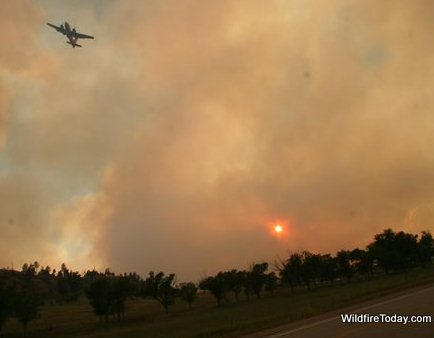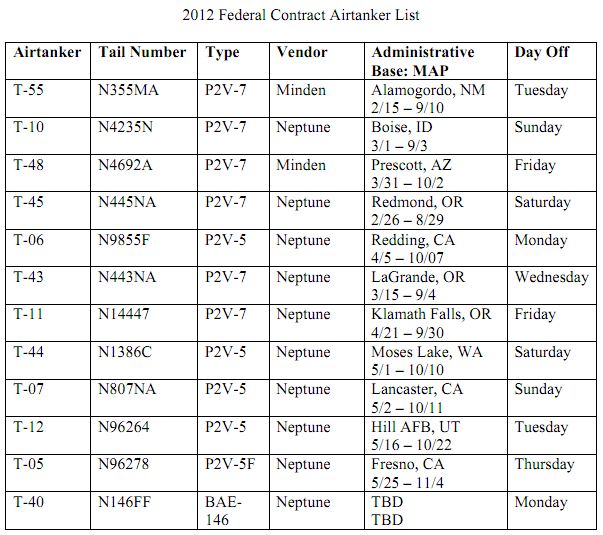
We were recently interviewed by Steve Wilent who wrote an article about what we are calling the air tanker crisis for The Forestry Source, a publication of the Society of American Foresters. The article is reprinted here with their permission.
=============================================================
From the July 2012 edition of The Forestry Source. © 2012, The Society of American Foresters (www.eforester.org)
Forest Service Bolsters Airtanker Fleet After Two Crashes
By Steve Wilent, Editor, The Forestry Source
As massive wildfires burning in the Southwest made for an ominous beginning to the 2012 fire season, two airtankers crashed in June, leaving two crew members dead and underscoring warnings about the safety of the US Forest Service’s aging and depleted fleet. Both aircraft were 50-year-old Lockheed P2Vs originally designed for US military anti-submarine patrols. With the crashes, the agency had just 9 large airtankers under contract, down from a fleet of 44 in 2002.
The two firefighters died in the same June 3 crash in western Utah when their P2V veered off course and slammed into mountainous terrain, according to a preliminary National Transportation Safety Board report. The second accident occurred on the same day near Reno, Nevada, when another P2V crash-landed after its landing gear failed to deploy.
“The pilots of Tanker 11 lost their lives protecting public safety and natural resources,” said Tom Harbour, Director of Fire and Aviation Management for the U.S. Forest Service. “As the entire fire and aviation community grieves their loss, we must ensure that we maintain our capability to fulfill our responsibilities to be prepared to respond vigorously to wildfires threatening people, communities, infrastructure, and natural and cultural resources.”
On June 11, the agency announced the addition of eight aircraft to the fleet, including one DC-10, and said it would arrange for 5 additional large helicopters to be activated earlier than scheduled. On June 13, President Obama signed a bill, rushed through Congress after the two crashes, that waives certain Forest Service airtanker contracting requirements, allowing the agency to speed up issuing contracts for “next generation” aircraft.
Even before the crashes, critics called for strengthening of the agency’s weakened airtanker fleet.
“With an aging fleet that has dwindled from 44 airtankers in 2002 to 11 this year, and will continue to decline in the years to come, I am unconvinced the USFS’s current airtanker fleet is prepared to adequately address an immense wildfire or even what is sure to be a long fire season,” wrote Colorado Sen. Mark Udall in an April 12 letter to Forest Service Chief Tom Tidwell.
Such concerns are not new. Following the crashes of two airtankers in 2002—one of which was filmed by a television news crew as its wings broke off in mid-air—the Forest Service and Bureau of Land Management commissioned a Blue Ribbon Panel to assess the federal wildfire aviation program. Among its eight major findings, the panel determined that “The safety record of fixed-wing aircraft and helicopters used in wildland fire management is unacceptable.” The report is available on the Source Extras page, www.safnet.org/members/archive/source_extras.cfm.
Since then, more-stringent safety requirements and inspections have led to many aircraft being deemed less than airworthy, a key factor in the reduction in the fleet’s numbers.
In February, the Forest Service released a “Large Airtanker Modernization Strategy” (www.fs.fed.us/fire/aviation/) that recommended contracting for 18 to 28 “next generation” large airtankers that are more reliable, faster, and can carry more retardant than the “legacy” airtankers.
2002 Report Still Valid
Former Texas state forester Jim Hull, now retired, was co-chair of the Blue Ribbon Panel.
“The report that we did nearly a decade ago is just as valid today as it was back then,” Hull said in a June interview. “There has been a continuous cycle of trying to use the old, worn-out military planes, and we’ve been doing this now for over 50 years. At some point, somebody’s got to wake up and realize that we’ve got to do something different.”
However, Hull cautions against assuming that the age of the aircraft had anything to do with the two crashes in June, pending a final report by the National Transportation Safety Board.
“It seems to me that one of our findings seems to be continually overlooked,” Hull said. “And that is the fact that no one in Congress or the administrations since then, whichever party has been in power, has seemed inclined to wake up to the fact that this is a national issue. It’s not a Forest Service or BLM issue, it’s a national issue—it’s going to take national leadership to provide adequate aerial firefighting capability for the nation. You can’t blame the agencies. I think they’re probably doing the best that they can possibly do with the funds that they have. Until the leadership of the nation is willing to mandate [the establishment of a modern airtanker fleet] and the funding to go with it, I don’t see any way that were going to resolve this problem.”
Bill Gabbert, former executive director of the International Association of Wildland Fire and editor of the Wildfire Today web site (wildfiretoday.com), said the Forest Service bears the responsibility for the state of the airtanker fleet.
“Since the fatal crashes in 2002, the Forest Service just hasn’t stepped up to the plate to make any decisions,” Gabbert said. “They have not shown any leadership on how to rebuild the fleet. They have managed the problem strictly in a negative sense, by banning certain types of aircraft from the fleet, but they haven’t done anything to encourage or make it easier for the private contractors to add to their fleets. It’s extremely difficult under the current procedures for a private vendor to buy an aircraft and pay to have it retrofitted as an airtanker.”
A key factor, Gabbert said, is that a contractor seeking a loan to buy and retrofit an aircraft can’t show a bank that it will receive enough income to justify the loan.
“There’s no guarantee that a contractor will receive a certain amount of income, even if they do get a contract for an aircraft. They don’t know how much they will fly or how much they will make. They don’t know if the aircraft will pass tests by the Inter-Agency Airtanker Board. There are just too many unknowns. There are just too many unknowns,” said Gabbert.
The solution, said Gabbert, is for the agency to purchase its own airtankers.
“I’ve reluctantly come to the conclusion that about the only way to ensure that we rebuild the fleet with safe aircraft is for the Forest Service to come up with a specific proposal, not one full of generalities like they did a few months ago [with the Large Airtanker Modernization Strategy],” he said. “They need to submit a specific, detailed proposal to Congress to ask for money to buy brand-new aircraft, including funding to retrofit them as airtankers. Brand-new, state-of-the-art, safe aircraft. And then they should issue contracts to private contractors to fly and maintain those airtankers. If we don’t do that, then we are just going to get more old, discarded aircraft.”






